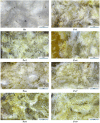Thermal and Sound Insulation Properties of Organic Biocomposite Mixtures
- PMID: 38475356
- PMCID: PMC10934450
- DOI: 10.3390/polym16050672
Thermal and Sound Insulation Properties of Organic Biocomposite Mixtures
Abstract
Sustainable building materials with excellent thermal stability and sound insulation are crucial for eco-friendly construction. This study investigates biocomposites made from cellulose pulp reinforced with beeswax, fir resin, and natural fillers like horsetail, rice flour, and fir needles. Eight formulations were obtained, and their thermal resistance, oxidation temperature, and acoustic properties were evaluated. Biocomposites exhibited significant improvements compared to conventional materials. Oxidation temperature onset increased by 60-70 °C compared to polyurethane foam or recycled textiles, reaching 280-290 °C. Sound absorption coefficients ranged from 0.15 to 0.78, with some formulations exceeding 0.5 across mid-frequencies, indicating good sound-dampening potential. These findings demonstrate the promise of these biocomposites for sustainable construction, offering a balance of thermal and acoustic performance alongside environmental and health benefits.
Keywords: biocomposites; internal architectures; paper pulp; sound insulation; thermal properties.
Conflict of interest statement
The authors declare no conflicts of interest.
Figures






References
-
- Alabdulkarem A., Ali M., Iannace G., Sadek S., Almuzaiqer R. Thermal analysis, microstructure and acoustic characteristics of some hybrid natural insulating materials. Constr. Build. Mater. 2018;187:185–196. doi: 10.1016/j.conbuildmat.2018.07.213. - DOI
-
- Ouhaibi S., Gounni A., Belouaggadia N., Ezzine M., Lbibb R. Thermal performance of new ecological material integrated into residential building in semi-arid and cold climates. Appl. Therm. Eng. 2020;181:115933. doi: 10.1016/j.applthermaleng.2020.115933. - DOI
-
- Asdrubali F., D’Alessandro F., Schiavoni S. A review of unconventional sustainable building insulation materials. Sustain. Mater. Technol. 2015;4:1–17. doi: 10.1016/j.susmat.2015.05.002. - DOI
-
- Thyavihalli Girijappa Y.G., Mavinkere Rangappa S., Parameswaranpillai J., Siengchin S. Natural fibers as sustainable and renewable resource for development of eco-friendly composites: A comprehensive review. Front. Mater. 2019;6:226. doi: 10.3389/fmats.2019.00226. - DOI
-
- Rusu R.D., Abadie M.J. Polyimide for Electronic and Electrical Engineering Applications. IntechOpen; London, UK: 2020. New High-Performance Materials: Bio-Based, Eco-Friendly Polyimides.
Grants and funding
LinkOut - more resources
Full Text Sources

